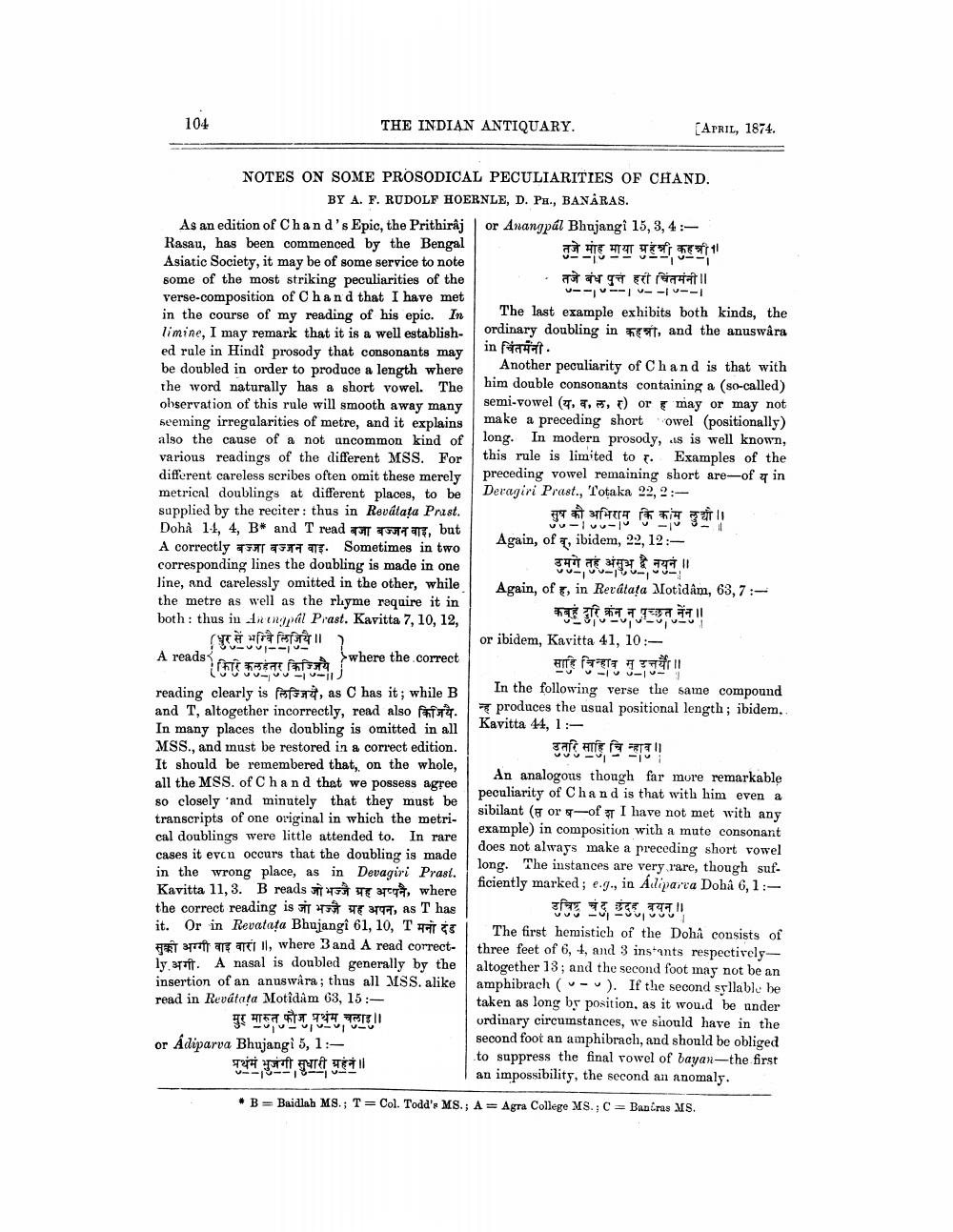________________
104
THE INDIAN ANTIQUARY.
(APRIL, 1874.
NOTES ON SOME PROSODICAL PECULIARITIES OF CHAND.
BY A. F. RUDOLF HOERNLE, D. PH., BANARAS. As an edition of Chand's Epic, the Prithiraj | or Anangpal Bhujangi 15, 3, 4 :Rasau, has been commenced by the Bengal Asiatic Society, it may be of some service to note some of the most striking peculiarities of the
.
til verse-composition of Chand that I have met
-- -- -- -- in the course of my reading of his epic. In The last example exhibits both kinds, the limine, I may remark that it is a well establish- ordinary doubling in it, and the anuswara ed rule in Hindi prosody that consonants may
in for be doubled in order to produce a length where
Another peculiarity of Chand is that with the word naturally has a short vowel. The
him double consonants containing a (so-called) observation of this rule will smooth away many
semi-vowel (T. T., 1) or may or may not seeming irregularities of metre, and it explains make a preceding shortowel (positionally) also the cause of a not uncommon kind of long. In modern prosody, as is well known, various readings of the different MSS. For this rule is limited to r. Examples of the different careless scribes often omit these merely preceding vowel remaining short are-of q in metrical doublings at different places, to be Deragiri Prast., Totaka 22,9:supplied by the reciter: thus in Revátata Prust.
T ATTU HTT! Dohi 14, 4, B* and T read to p ay, but
Again, of 7, ibidem, 22, 12:A correctly बज्जा बज्जन वाइ. Sometimes in two corresponding lines the doubling is made in one
उमगे तह अंसुभ है नुयुनं ।। line, and carelessly omitted in the other, while Again, of, in Rerdtata Motidâm, 63, 7:the metre as well as the rhyme require it in both: thus in Arengpal Prast. Kavitta 7, 10, 12,
कबुहं दुरि क्रन न पृच्छत नेन। fra II
or ibidem, Kavitta 41, 10:A where the correct
साहि चिन्हाव म उन]॥ reading clearly is pofsit, as C has it; while B
In the following verse the same compound and T, altogether incorrectly, read also feat.
produces the usual positional length; ibidem.
Kavitta 44, 1:In many places the doubling is omitted in all MSS., and must be restored in a correct edition.
TC HTC, ETT! It should be remembered that, on the whole,
An analogous though far more remarkable all the MSS. of Chand that we possess agree
peculiarity of Chand is that with him 80 closely and minutely that they must be
even a
sibilant (p or -of transcripts of one original in which the metri
I have not met with any
example) in composition with a mute consonant cal doublings were little attended to. In rare
does not always make a preceding short vowel cases it even occurs that the doubling is made in the wrong place, as in Devagiri Prasl.
long. The instances are very rare, though suf
ficiently marked; e.9., in Aliparra Doha 6,1:Kavitta 11, 3. B reads TT + TEC#, where the correct reading is जो भज्जै ग्रह अपन, as T has
उत्रिष्ट चंड, छंदुइ, व्युन । it. Or in Revatata Bhujangi 61, 10, T H 5 The first hemistich of the Dohî consists of F arf an art II, where 3 and A read correct- three feet of 6, 4, and 3 instants respectively ly, araft. A nasal is doubled generally by the altogether 13; and the second foot may not be an insertion of an anuswara ; thus all MSS. alike amphibrach (veu). If the second syllable he read in Revatata Motidam 63, 15:
taken as long bs position, as it wou.d be under JE HTETETİ, PIENI
ordinary circumstances, we should have in the or Adiparva Bhujangi 5, 1:
second foot an amphibrach, and should be obliged
to suppress the final rowel of bayan-the first प्रथमं भुजंगी सुधारी ग्रहनं ॥
an impossibility, the second an anomaly.
A reads TT
AUTRES
* B = Baidlab MS.; T = Col. Todd's MS.; A = Agra College MS.; C = BanCras MS.




